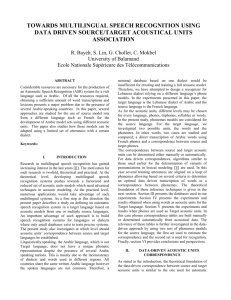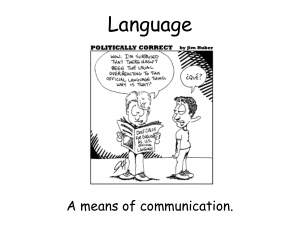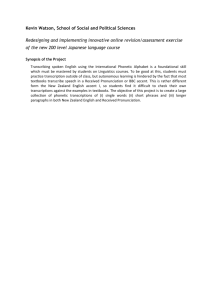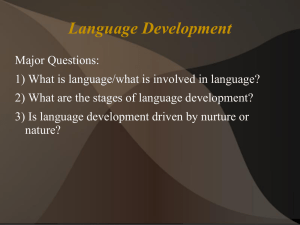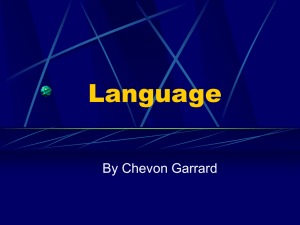4.1. Manual transcription
advertisement
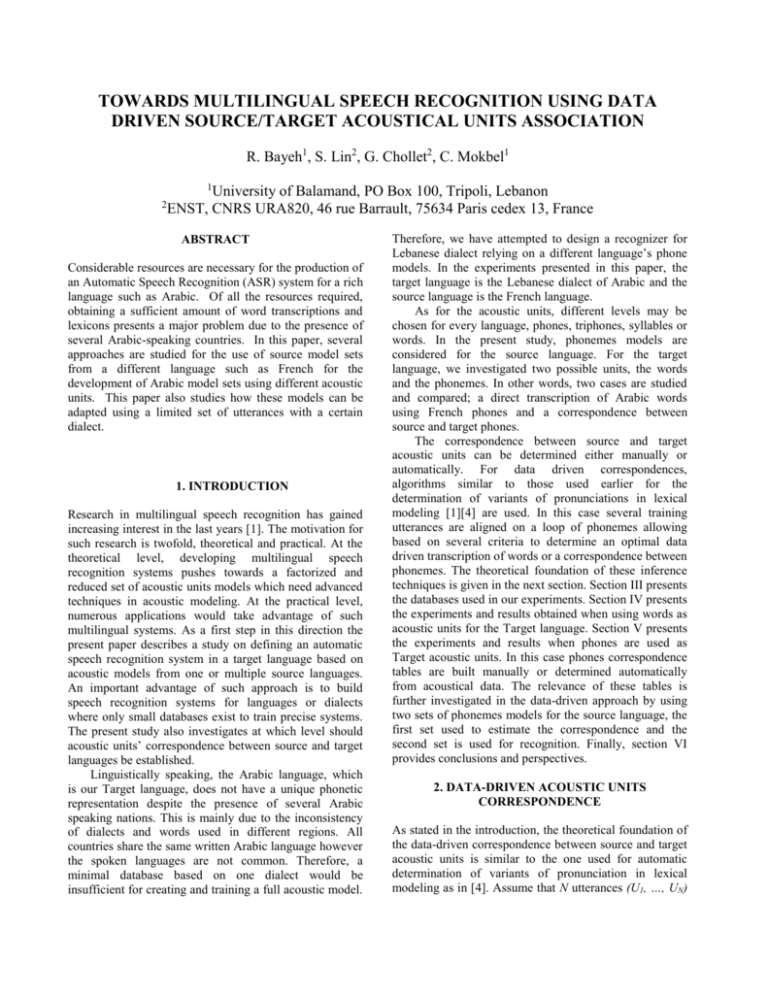
TOWARDS MULTILINGUAL SPEECH RECOGNITION USING DATA DRIVEN SOURCE/TARGET ACOUSTICAL UNITS ASSOCIATION R. Bayeh1, S. Lin2, G. Chollet2, C. Mokbel1 1 2 University of Balamand, PO Box 100, Tripoli, Lebanon ENST, CNRS URA820, 46 rue Barrault, 75634 Paris cedex 13, France ABSTRACT Considerable resources are necessary for the production of an Automatic Speech Recognition (ASR) system for a rich language such as Arabic. Of all the resources required, obtaining a sufficient amount of word transcriptions and lexicons presents a major problem due to the presence of several Arabic-speaking countries. In this paper, several approaches are studied for the use of source model sets from a different language such as French for the development of Arabic model sets using different acoustic units. This paper also studies how these models can be adapted using a limited set of utterances with a certain dialect. 1. INTRODUCTION Research in multilingual speech recognition has gained increasing interest in the last years [1]. The motivation for such research is twofold, theoretical and practical. At the theoretical level, developing multilingual speech recognition systems pushes towards a factorized and reduced set of acoustic units models which need advanced techniques in acoustic modeling. At the practical level, numerous applications would take advantage of such multilingual systems. As a first step in this direction the present paper describes a study on defining an automatic speech recognition system in a target language based on acoustic models from one or multiple source languages. An important advantage of such approach is to build speech recognition systems for languages or dialects where only small databases exist to train precise systems. The present study also investigates at which level should acoustic units’ correspondence between source and target languages be established. Linguistically speaking, the Arabic language, which is our Target language, does not have a unique phonetic representation despite the presence of several Arabic speaking nations. This is mainly due to the inconsistency of dialects and words used in different regions. All countries share the same written Arabic language however the spoken languages are not common. Therefore, a minimal database based on one dialect would be insufficient for creating and training a full acoustic model. Therefore, we have attempted to design a recognizer for Lebanese dialect relying on a different language’s phone models. In the experiments presented in this paper, the target language is the Lebanese dialect of Arabic and the source language is the French language. As for the acoustic units, different levels may be chosen for every language, phones, triphones, syllables or words. In the present study, phonemes models are considered for the source language. For the target language, we investigated two possible units, the words and the phonemes. In other words, two cases are studied and compared; a direct transcription of Arabic words using French phones and a correspondence between source and target phones. The correspondence between source and target acoustic units can be determined either manually or automatically. For data driven correspondences, algorithms similar to those used earlier for the determination of variants of pronunciations in lexical modeling [1][4] are used. In this case several training utterances are aligned on a loop of phonemes allowing based on several criteria to determine an optimal data driven transcription of words or a correspondence between phonemes. The theoretical foundation of these inference techniques is given in the next section. Section III presents the databases used in our experiments. Section IV presents the experiments and results obtained when using words as acoustic units for the Target language. Section V presents the experiments and results when phones are used as Target acoustic units. In this case phones correspondence tables are built manually or determined automatically from acoustical data. The relevance of these tables is further investigated in the data-driven approach by using two sets of phonemes models for the source language, the first set used to estimate the correspondence and the second set is used for recognition. Finally, section VI provides conclusions and perspectives. 2. DATA-DRIVEN ACOUSTIC UNITS CORRESPONDENCE As stated in the introduction, the theoretical foundation of the data-driven correspondence between source and target acoustic units is similar to the one used for automatic determination of variants of pronunciation in lexical modeling as in [4]. Assume that N utterances (U1, …, UN) from the Target language are available for training and that the acoustical models for the Source language are (1,…, p). We define (1, …, q) the q acoustical models for the Target language and we suppose that a target model can be expressed as a function of the source acoustic models: i f i (1 ,, p ) i 1, q (Eq. 1) Given that, in the target language, every utterance is expressed as a succession of target acoustical units, the general optimization problem is to find fˆi such as: fˆ argmax p U ,U i 1 N / 1 ,, q fi (Eq. 2) The optimization to be performed in (Eq. 2) depends on the nature of the source and target acoustical units and on the type of functions fˆi . In the present work the source units are phonemes and two cases are considered for the target units, i.e. words and phonemes. If the word is considered to be the basis for target acoustic unit, the nature of fˆi will determine the optimization algorithm. If fi is the transcription of ith target word using the source phonemes, we should find the phoneme sequence leading to the highest likelihood for the training sequences of the ith word. As in[4], an N-best alignment of the ith word training utterances on a loop of source phonemes models provides several solutions and the solution leading to the maximum likelihood is kept. If k possible transcriptions are possible, then k solutions will be selected among the different alignments. When phonemes are considered as basic target units, the fˆi represent source-to-target phonemes association. This association has to be inferred from training utterances. For this purpose, training utterances are segmented into phonemes. These utterances are then aligned on the source phonemes loop. For every target phoneme the corresponding acoustic segments are selected. The target phoneme is associated with the top m source phonemes having maximum overlap with its acoustic segments. Once the correspondence between source units and target units determined, the parameters of the source models may be adapted to better describe the distribution of the training target utterances. Several techniques may be used for adaptation purposes [2]. The experiments conducted in this work are limited to the MLLR adaptation. 3. DATABASES AND PHONETIC REPRESENTATIONS Two databases are used in our experiments, Swiss French Polyphone [5] database and an Arabic (Lebanese dialect) database. The Swiss French Polyphone consists of approximately 10 sentence samples and 28 isolated words for 5,000 speakers. Two sets of phone models are trained on this database. . The first set of phone models, referred to as PL16 in this paper, consists of 42 phone models including 2 silence models and 6 closures. The second set, PL32, a total of 36 phone models, is trained on 9938 phonetically rich sentences spoken by 1000 speakers (500 men, 500 women) and the plosive models are created as a single phone model. Both model sets are three-state leftto-right Hidden Markov Models (HMMs), the PL16 set with 16 component Gaussian mixture distributions associated with each state whereas the second set of models has each state emission density comprising 32 Gaussian mixture components. The Arabic database, on the other hand, is a SpeechDat like telephone database collected at the University of Balamand (UOB). This database contains 923 isolated word samples collected from approximately 50 male and female speakers between the ages 18 and 25. 550 samples, approximately 14 word utterance per speaker, of this database are used as the target language database and are divided into two sets, one for training (208 samples) and the other for testing (342 samples). The training utterances were segmented into phonemes and used for alignment and adaptation. HTK [2] was used to train these models. As feature vectors, 13-components MFCC vectors are extracted from 25.6ms windows every 10ms. The first- and second-order derivatives are associated to the static MFCC vectors leading to a feature vector with 39 components. For phonetic representation, the IPA (International Phonetic Alphabet), which is a well-known and useful tool in exploring phonetic similarity across languages, is used along with SAMPA, the keyboard representation of its sample at this stage for all Arabic transcriptions [3]. The French phone models, however, relied on S2 standard and were changed to SAMPA in the second approach. 4. TARGET LANGUAGE WORDS ASSOCIATED WITH SOURCE LANGUAGE PHONEMES In the first case, phonetic sequences using the source model set were created either manually or automatically for each target word in the corpus. These sequences were then used along with start and end silence nodes for the creation of word networks. Finally, adaptation using the training utterances was conducted and performance was evaluated using the test utterances. The following sections describe the determination of the sequences both manually and automatically and their corresponding results. 4.1. Manual transcription The acoustic evidence for each word in the target corpus was used to determine its best phonetic representation in this approach. Although the corpus consists of Lebanese dialect samples only, the accents of different geographical regions led to more than one transcription for each word in some cases. Some example sequences are shown in Table 1. Models for the Arabic vocabulary were built based on these transcriptions. The training utterances were used to adapt those models. Table 1 – Manual Word Transcriptions Arabic Pronunciation French Transcription 3amil akfil alka2ima barmij … an mm ei ll ai mm ei ll aa kk ff ei ll aa ll kk aa ii mm aa bb aa rr mm ei jj … Table 2 –Automatic Word Transcriptions Arabic Pronunciation 3amil kalla a_nine barmij … French Transcription ff an in mm ai ll ss ff an in mm ee ll ss ff an in mm ee ii ll un kk aa ll rr kk aa ll pp kk aa ll ai tt ee ss aa tt ee ss in tt ee ss ii in bb aa mm ei ch ii bb ei ch ai mm ei ch … 4.2. Automatic transcription To automatically associate each of the target words with a sequence of phonemes, recognition was conducted on the training utterances using an elementary loop of phonemes to produce N-best results. The three recognized sequences with the highest likelihood are selected for each word. These transcriptions (e.g. Table 2) referred to as automatic phonetic transcriptions were used to build a new model which was adapted and evaluated. This approach also included the both manually and automatically in a tabular way. These tables, together with lexical description of target words in terms of target language phones, were then used to create the new model by copying the source unit model and renaming it according to the target phone it represents. Finally, as was the case in the previous method, recognition and MLLR adaptation were conducted. 5.1. Manual correspondence Similar to the manual transcription method, correspondence was done relying on the human auditory system. An association table, sample of which is shown in Table 3, was manually created relating each Arabic phone to one or more French phones. A total of eight sets of models were created, each of which contains a different correspondent French phone for the phones with several mappings. Table 3 – Phone Correspondence Arabic Symbol Arabic Word French Symbol French Word b t T Z … ba:b (door) tis?’ (nine) Tala:T (three) Zami:l (pretty) … bb tt ss jj … bateau tete salut jardin … 5.2. Automatic correspondence To automatically create a correspondence table, the first step was simple recognition of the target utterances in the training set using a simple source units loop. Upon comparing the resulting transcriptions with the original ones, the ratio of correspondence of each target unit to each source unit was calculated. Finally, the French unit with the highest ratios for each target phone were joined to create an association file similar to Table 3. A sample of the automatic correspondence results obtained for each 5. PHONEMES CORRESPONDENCE TABLES Word is the largest target language unit which would offer the best modeling precision using another language smaller units. However, this requests to regenerate a new lexical dictionary for the target language. It would be practical if an association of smaller units could be found. Therefore, phonemes association was studied. The mapping between the target and source units was done Figure 1- Automatic Correspondence Graph for POLY 7. REFERENCES Transcription Approach 70 65 60 Correct Rate set of phone models is shown in Figure 1. The gray scale chart give forth two model sets for PL16 (PL16_1, PL16_2) and a single model set for PL32. This approach also includes using the PL16 automatic correspondence table along with the PL32 model sets for the creation of the new target models. This final set was referred to as PL16_32. PL16 55 PL32 PL16_32 50 PL32_16 45 6. CONCLUSIONS AND PERSPECTIVES 40 35 The previous sections discussed the correspondence between source and target acoustic units both manually and automatically. Figures 3 and 4 compare the highest results yielded by each method involved for each of PL16 and PL32 respectively. 0 0.5 1 1.5 2 2.5 3 3.5 Adaptation Level Figure 5- Automatic Transcription recognition results. Correspondence Approach 70 65 Correct Rate PL16 Approaches 65 Correct Rate 60 55 AT_PL16 60 PL16 PL32 PL32_16 55 50 MT_PL16 50 AC_PL16 MC_PL16 45 45 0 0.5 1 1.5 2 2.5 3 3.5 Adaptation Level 40 Figure 6- Automatic correspondence recognition results. 35 0 0.5 1 1.5 2 2.5 3 3.5 Adaptation Level Figure 3- PL16 word recognition for all methods. PL32 Approaches 71 [1] E. Wong, T. Martin, S. Sridharan, T. Svendsen, “Multilingual Phone Clustering for Recognition of Spontaneous Indonesian Speech Utilizing Pronunciation Modeling Techniques”, Proc. EuroSpeech’03, Vol., pp 3133-3136, 2003 70 Correct Rate 69 AT_PL32 68 MT_PL32 67 AC_PL32 66 MC_PL32 [2] Odell J, Ollason D, Woodland P, Young S, Jansen J, “The HTK Book for HTK V3.2”, Cambridge University Press, Cambridge, UK, 2002. 65 64 63 0 0.5 1 1.5 2 2.5 3 3.5 Adaptation Level Figure 4- P32 word recognition for all methods. In this paper, we presented a two-tiered approach for porting ASR technology from a source language to a target language with limited resources. The limited amount of data led to the use of different target units in the acoustic models correspondence. To reduce manual labor, we tried to do this automatically with each type of target units and the results are shown in Figure 5 and 6. It is evident that performance is much higher with PL32 with the plosive models transcribed as a single phone. [3] IPA, Handbook of the International Phonetic Association: a guide to the use of the International Phonetic Alphabet, Cambridge University Press, 1999. [4] H. Mokbel, D. Jouvet, “Automatic derivation of multiple variants of phonetic transcriptions from acoustic signals,” Proc. EuroSpeech’97, Vol. 3, 1997. [5] G. Chollet, J.-L. Cochard, A. Constantinescu, C. Jaboulet, Ph. Langlais, “Swiss French Polyphone and PolyVar: Telephone Speech Databases to model inter- and intra-speaker variability”, IDIAP-RR 96-01, 1996.
